Born in the Dutch Golden Age, Dutch painter Johannes Vermeer was a well-known artist during the Baroque style of art.
His artworks portrayed domiciliary scenes in the most elusive and tangible ways.
Known for the use of costly pigments in his paintings, his expertise in handling colors spoke about the passion he had for art.
Johannes Vermeer’s paintings depict the use of natural light with certain nuances that make it look surreal.
Being one of the prominent artists of the Dutch Golden Age, his artworks gained popularity two centuries later, in the 19th century.
The speculated reason behind Johannes Vermeer’s paintings not becoming popular in his prime might be the fact that he produced fewer paintings than other renowned artists of the Dutch Golden Age.
In his career, Johannes Vermeer created over 36 paintings. The majority of them depict European middle-class household scenarios.
After knowing about the artist and his background, let’s take a look at Vermeer’s artworks, which depict life in the most subtle way.
Table of contents
- Girl With A Pearl Earring
- The Milkmaid
- The Procuress
- Women Holding A Balance
- The Concert
- Women With A Water Jug
- Woman Reading A Letter
- The Lacemaker
- Diana And Her Companions
- A Maid Asleep
- Saint Praxedis
- The Little Street
- View Of Delft
- Women With A Pearl Necklace
- Mistress And Maid
- Epilogue:
- Author’s Note:
1. Girl With A Pearl Earring
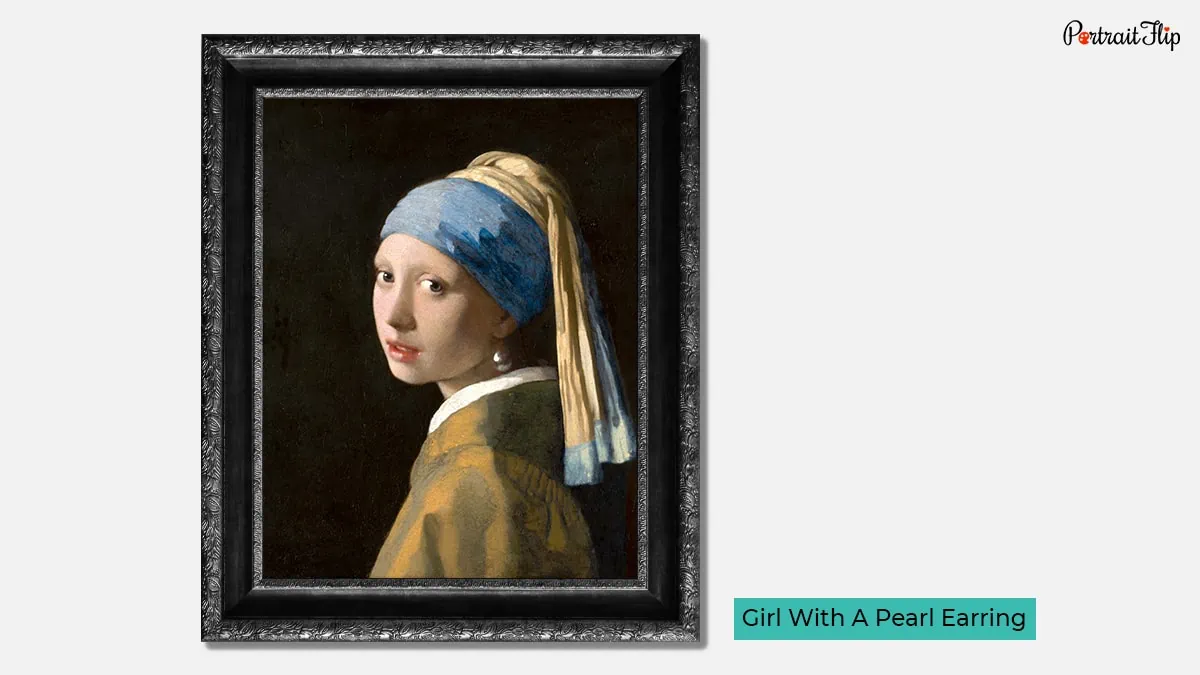
The famous Dutch painter from the 1600s, Johannes Vermeer produced a painting, “Girl with a Pearl Earring,” which is considered as the Mona Lisa of the North.
The painting was made on a canvas with oil paint in 1665, which belongs to the tronie genre.
The girl in this painting is looking towards her left with a mysterious expression. She seems to be in a state of confusion and suspicion at the same time.
Vermeer has painted her eyes with such intensity that they depict the ample amount of passion she has for the contemporaries of life. However, she’s bound to a single thing, which devalues her emotions.
Johannes Vermeer’s paintings have been in the golden eye of many art museums and galleries; many of them rest in The Hague, Netherlands, currently.
Vermeer was praised for using expensive pigments from over three different continents in this painting.
2. The Milkmaid
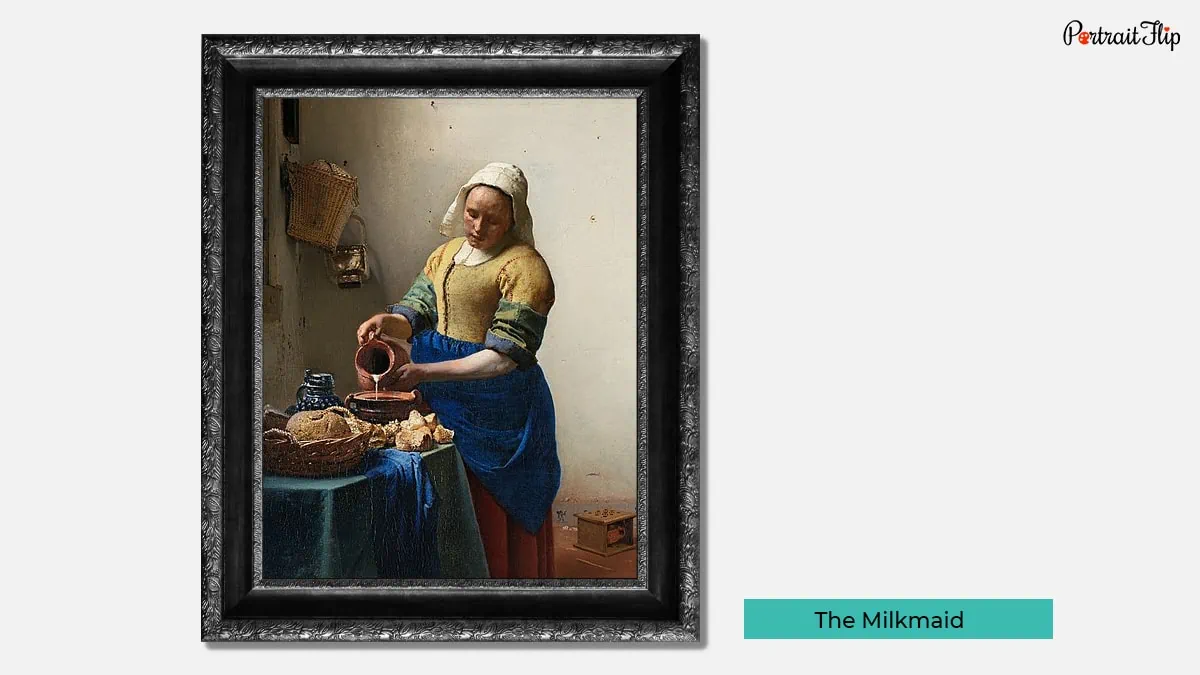
The Milkmaid is stored in the Rijksmuseum in Amsterdam; it’s considered one of the finest pieces of art from the Dutch Golden Age.
It depicts a domestic scene of a maid pouring milk into a vessel beside which there are a few broken pieces of bread lying on the table.
It’s a speculated fact that the maid is probably doing initial preparations to make bread pudding, a Dutch delicacy. Vermeer has justified this fact by depicting a focused facial expression on the maid.
The portrayal of the maid in this painting by Johannes Vermeer is very unusual, according to the 17th century. It is very graceful and subtle.
To address the elegance of the painting, Vermeer has used blue with a tint of white to explain the element of sunlight in the painting.
3. The Procuress
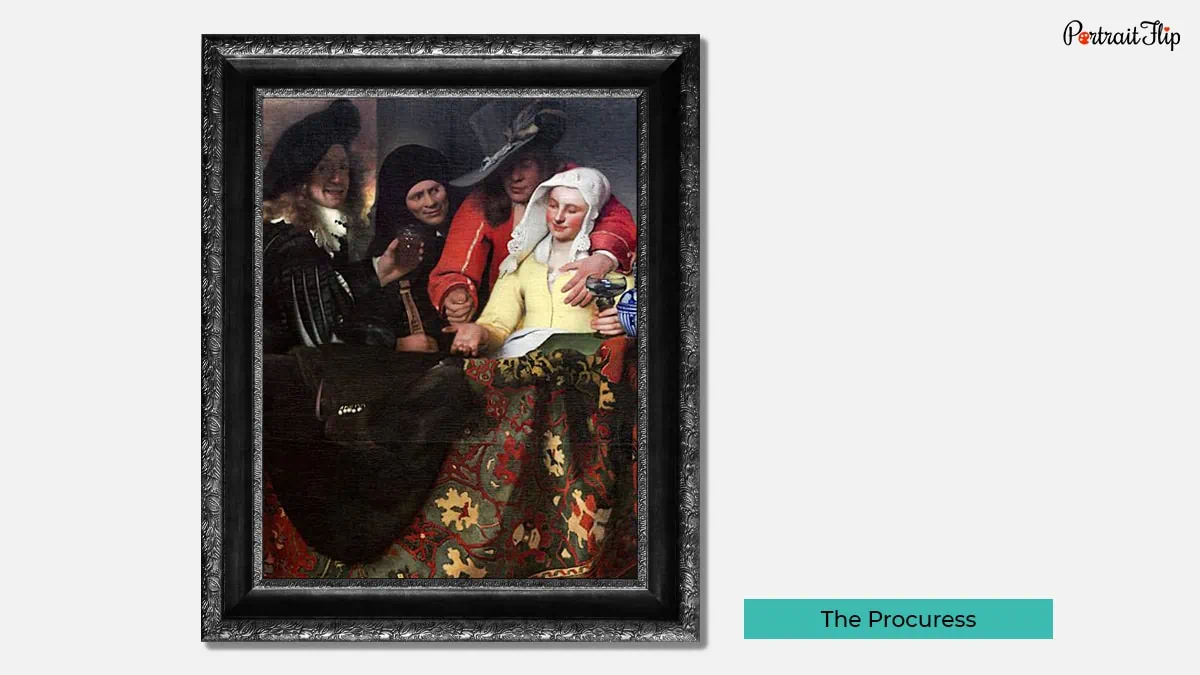
The Procuress, the most non-traditional of Johannes Vermeer’s paintings, portrays a scene from the brothel. This is a depiction of contemporary life during the Dutch Golden Age.
Undoubtedly one of the most famous paintings by vermeer, its title refers to someone who procures a prostitute for another person.
In this painting, the woman in the black costume with a gloomy expression is The Procuress and is the elemental subject.
The woman in the yellow dress being groped by the man in the red dress seems to be the prostitute. She is aware of the societal remarks and her spot in the community, but still, she looks pretty wholesome.
The two male figures in the painting portray the wealth and profligacy of the Dutch Golden Age. The man in the black dress looking towards the viewers is probably Johannes Vermeer’s self-portrait.
This artwork represents the parallel nature of life, as the prostitute is smiling while holding a glass tightly to absorb her pain and agony.
This artwork is often compared to Dick Van Baburen’s similar painting that was hung on a wall in Vermeer’s mother Maria’s house.
Recommended Read: Renoir Paintings
4. Women Holding A Balance
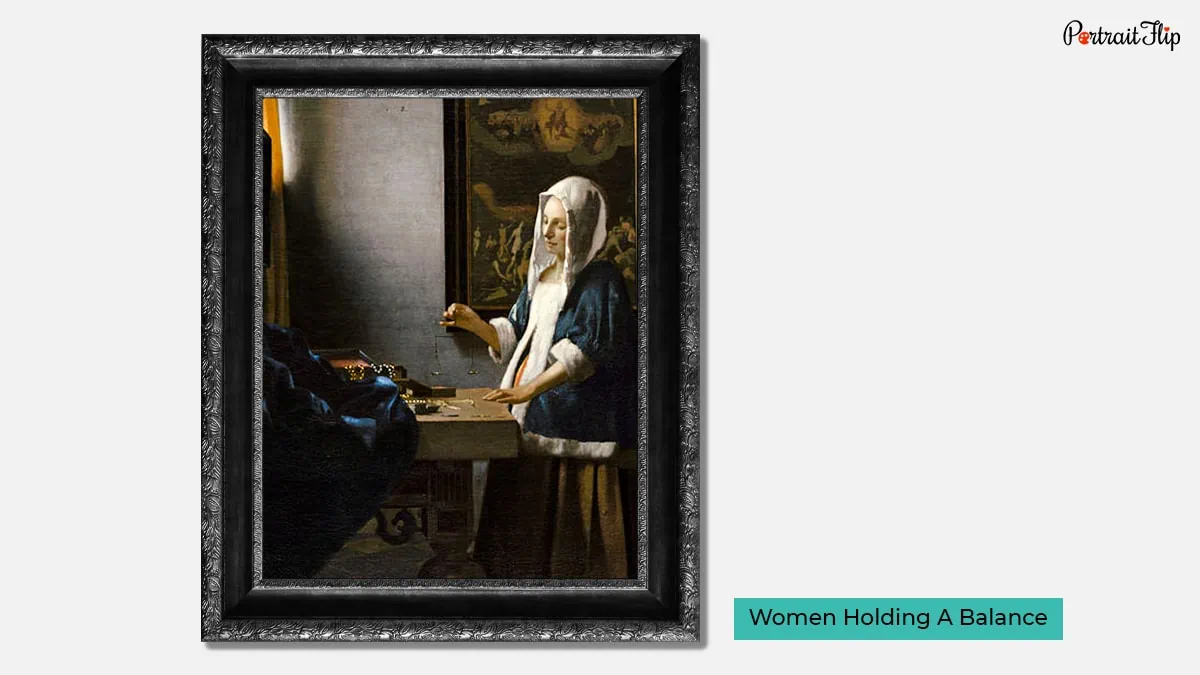
Women Holding a Balance is one of Vermeer’s paintings that astonished large numbers of art lovers.
It sits in the National Gallery of Art in Washington, DC, presently.
Vermeer’s excellence in blending natural light in an indoor setting using artificial pigments is clearly evident in this painting.
You can observe the slight reflection of light on the wall beside the subject. Vermeer used the slight wall reflection to make minute objects in the room moderately visible. Such as the subject’s facial expressions.
The woman in the painting looks very focused and aware while holding the balance. The gist of the painting is that the focal point of life is very dynamic.
The woman might be in a state of introspection and self-realization while testing the balance. The absence of bright colors gives evidence of a serious element in the painting.
The nuances on the face of the maid complements the sunlight coming from the window complement with sunlight.
5. The Concert
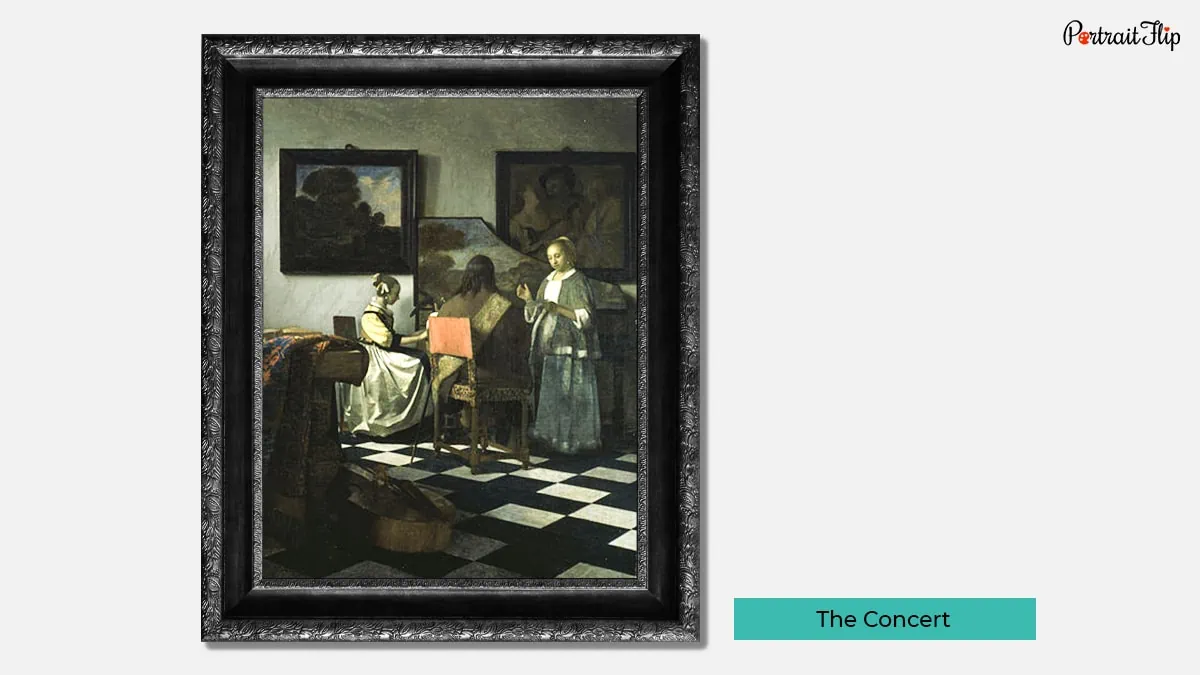
The Concert is undoubtedly one of the most controversial Johannes Vermeer’s paintings.
The tragic story of it is that it was stolen from Isabella Stewart Gardner museum, Boston in 1990 and has been missing since then
It depicts a man and two women playing piano in a comparatively brighter setting than his other paintings.
A domestic scene of practicing music in a Dutch household, it speaks about the music being a prominent recreational activity amongst the Dutch people of that era.
This is also drafted on oil and canvas using expensive pigments.
It’s considered one of Vermeer’s most valuable works, with an estimated value of US$250 million. However, the actual location of this artwork still remains a mystery.
Suggested Read: Paintings by Picasso
6. Women With A Water Jug
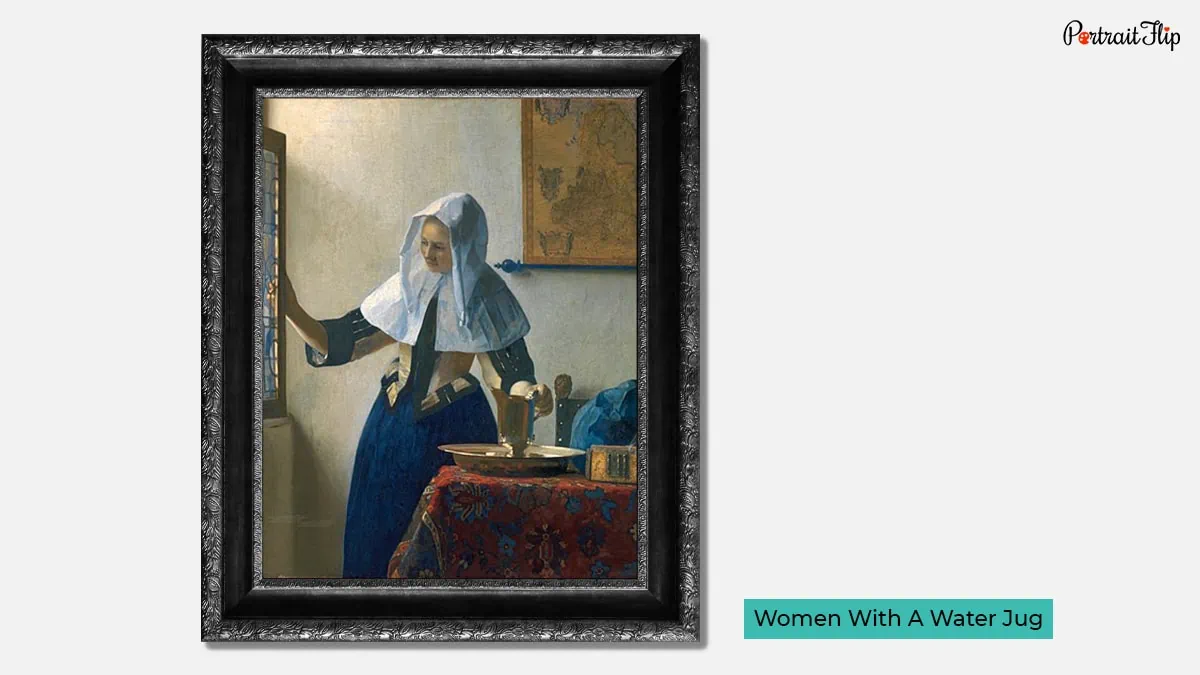
Women with a Water Jug, also known as “A Young Woman with a Water Pitcher” is an oil painting by Johannes Vermeer.
A young woman with a blissful smile on her face can be seen holding a jug of water with her left hand and a casement window with her right hand.
The woman is likely in an uplifting mood while looking out the window. Tired from her daily tasks while accomplishing one more, as soon as she sights someone special, a smile pops on her face.
How minute human feelings can get and how nuanced they are—these are some attributes extracted from this painting of the Dutch Golden Age.
Vermeer has used a luminous color tone for the depiction of the water jug and the platter beneath it. It represents wealth and purity, as per the Dutch Golden Age.
Just like this, most of Johannes Vermeer’s portraits depict the idealistic lifestyle of the Dutch middle class.
7. Woman Reading A Letter
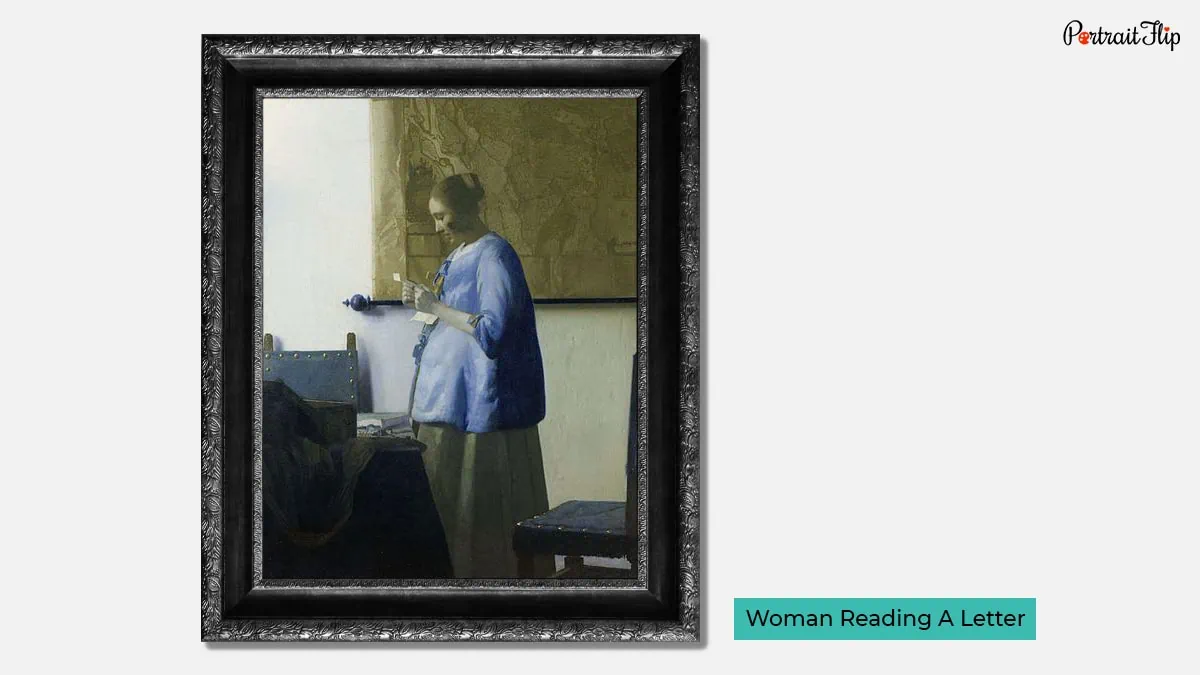
Being an expert in exemplifying domestic life, Johannes Vermeer’s painting talks a lot about the contemporary lives of Dutch women.
Women reading a letter is a sheer illustration of the same topic. The painting’s main subject is a woman in a light blue dress reading a letter.
The woman appears to be in the midst of a pregnancy. However, this was not a popular idea in paintings back then.
So, it could be a bulging gown as well. It’s still a debatable topic amongst art enthusiasts even today.
The subject’s facial expressions are portrayed so tightly that one glance could lead to a conclusion about the subject’s mindset.
She seems highly engaged in reading the letter, which gives us an idea about the context of the letter. It might be something very close and personal to her.
It could be a letter from one of her family members or her lover. The dull tonality of the painting depicts a vacuum around her thoughts and speaks the sound of silence in the room.
Again the use of light with great care and delicacy is evident in this painting as well.
Vermeer portrayed these set of memories in the form of beautiful paintings. Painted memories are really special!
Go ahead and Check Out Our Memorial Paintings Now!
8. The Lacemaker
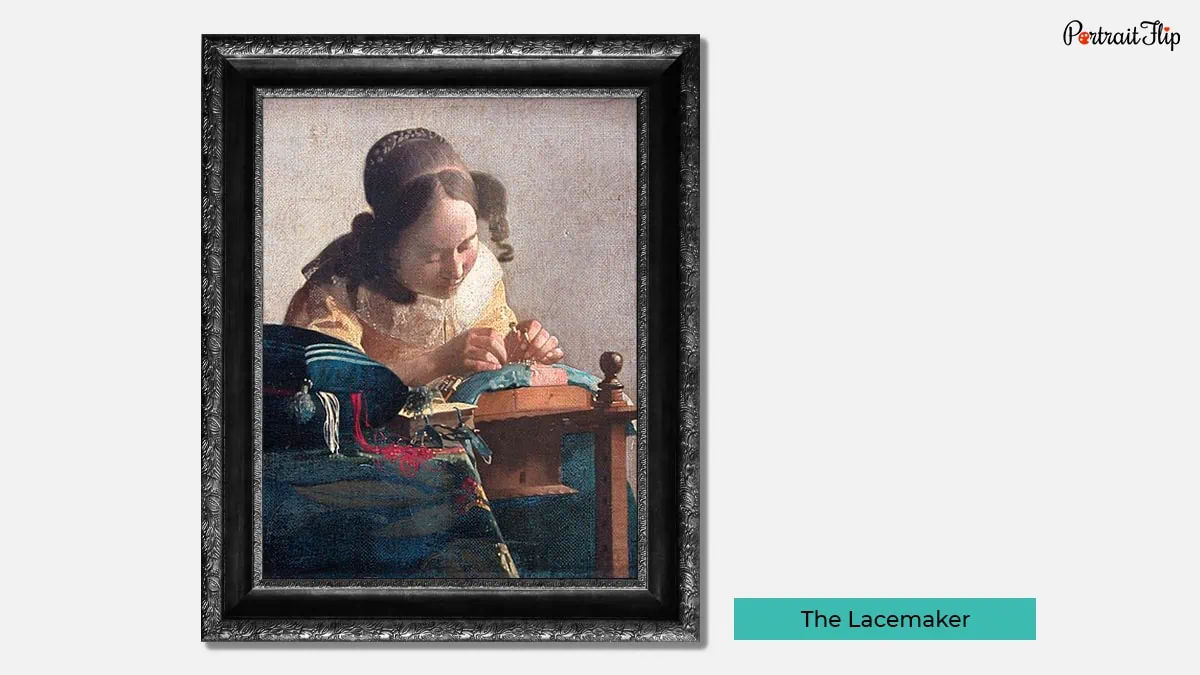
The Lacemaker, another great creation from Johannes Vermeer’s artworks, speaks about the profound sincerity of the women in the yellow bodice working with bobbin laces.
The Lacemaker is a highly nuanced artwork. The central subject is set in a blank background to give it a dominant vision.
The artist thoroughly displayed the nuances on the woman’s face. The level of concentration on her face tells us about the sincere nature of Dutch household women.
The central subject appears to be from a decent household, as her clothing depicts. Absorbed so much in her craft, seems like it means the world to her.
There’s a notion behind “The Lacemaker”, that Vermeer may have used a camera obscura while painting this artwork. Due to these Johannes Vermeer painting techniques, a lot of optical effects, such as projection and depth, are clearly visible in this painting.
Also Read: Paintings by Kandinsky
9. Diana And Her Companions
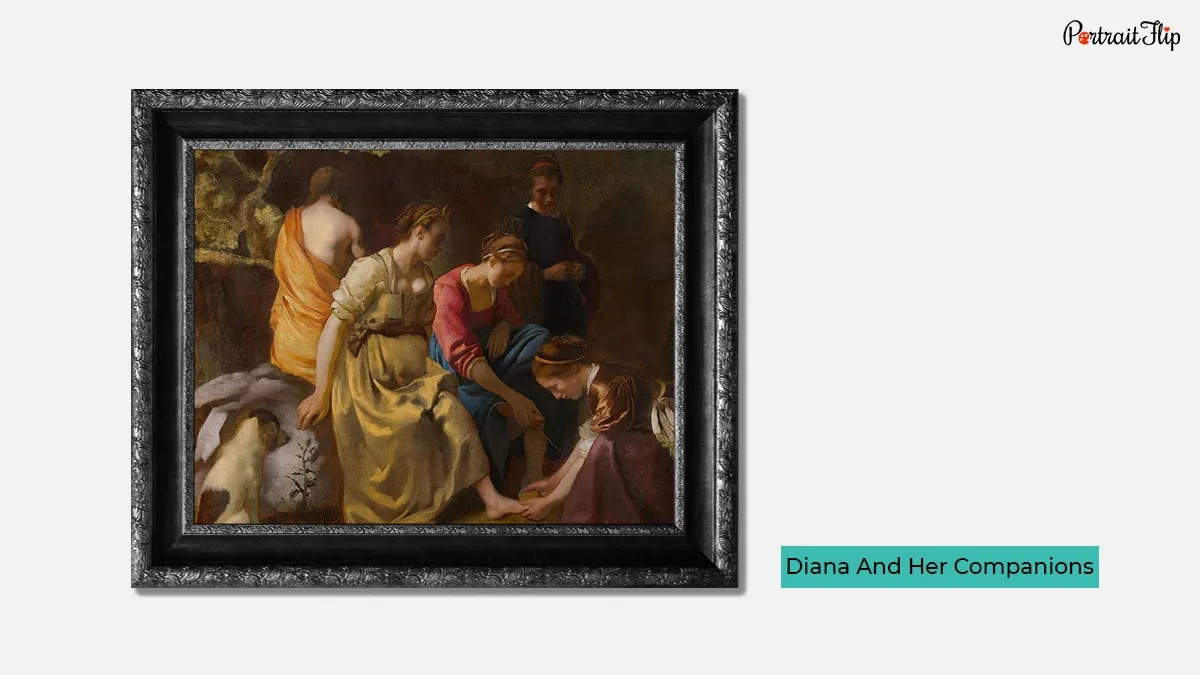
The artwork by Vermeer, Diana and Her Companions depicts a scene of some private time in Diana’s toilet. Diana, a Greek Roman goddess, can be seen with four of her companions, who are nymphs according to Greek mythology.
There are four women, and none of them is facing each other. The painting emphasizes the situation of women who were lost in their own thoughts.
This painting signifies “nothingness” and “universe” both in a single frame. The women signify nothingness and vacuum as they seem blank and their thoughts depict the universe
Goddess Diana is wearing a yellow dress and sitting on a rock. A nymph is washing her feet, and another one is seen sitting and holding her left foot with her right hand.
This is a type of Baroque painting and scenes like these are illustrated by other artists in the same style from the Baroque Era timeline.
10. A Maid Asleep
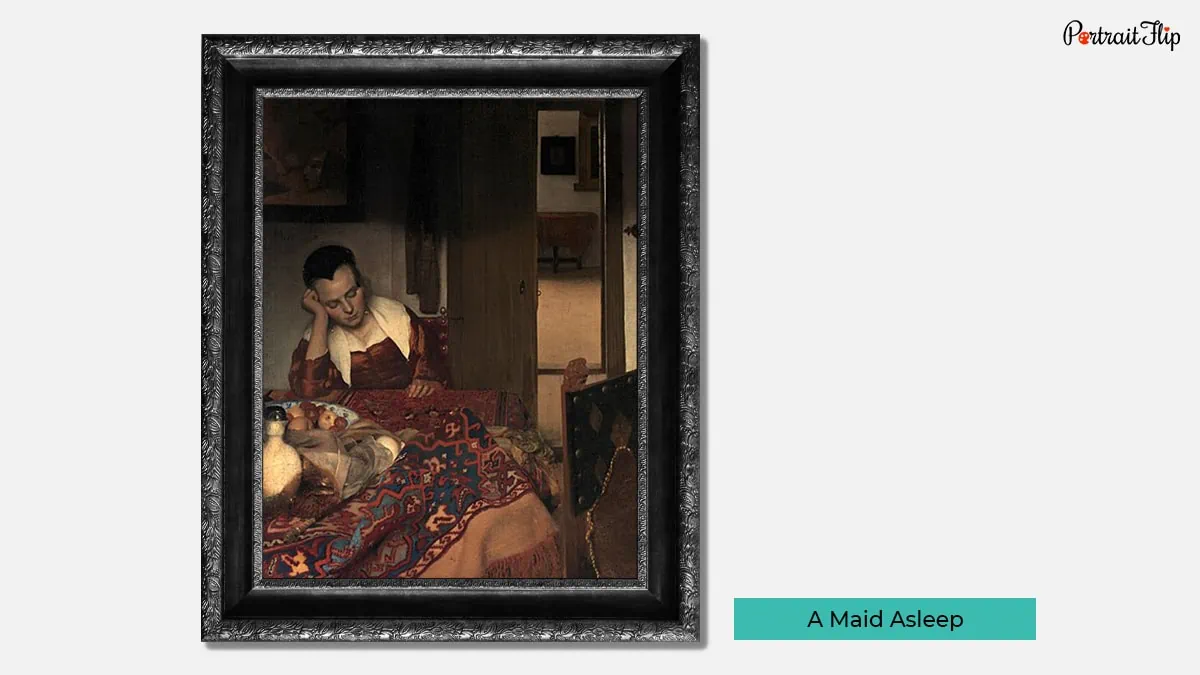
Crafted in 1657, A Maid Asleep is one of Johannes Vermeer’s paintings which depict the integral stances of a domiciliary women’s life in European households.
The central figure in the painting can be seen wearing a maroon dress with a white scarf on top. She seems exhausted after performing her routine work, trying to escape the tiredness by relaxing for a while.
This artwork by Vermeer depicts that life is not fair sometimes. As the maid seeks a little bit of rest from her tedious tasks, she might face the consequences if caught.
The plot of the painting is quite ordinary, but the depiction makes it excellent in every sense. The colors, the projection, the elements, and the details are exemplary.
11. Saint Praxedis
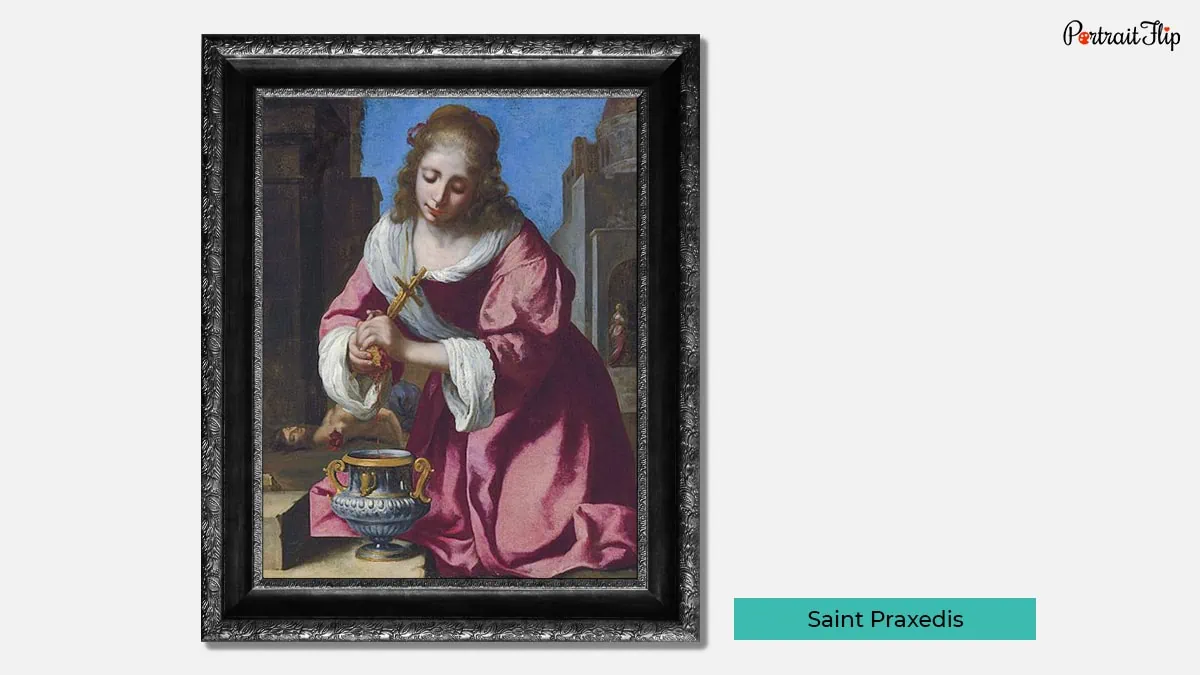
Probably one of the most famous paintings by Vermeer, it portrays the scene of a 2nd century saint; prexedis squashing a sponge filled with a martyr’s blood into a vessel.
Two opposite perspectives of nature are clearly visible in this painting. The barbaric one where the soldier is lying on the ground with his blood spilled all over.
Saint Praxedis collecting his blood while holding the holy crucifix represents the biblical aspect of this artwork. Vermeer has simplified the polarity of life in a single frame.
Saint Praxedis is considered controversial because of its comparison with Ficherelli’s similar work of the 1640s. The only significant difference between both paintings is the crucifix in the saint’s hand.
It’s an oil on canvas artwork dating back to probably 1655. It appears to be in a dark-themed setting. Presently, the painting is kept in the National Museum of Western Art, Tokyo.
12. The Little Street
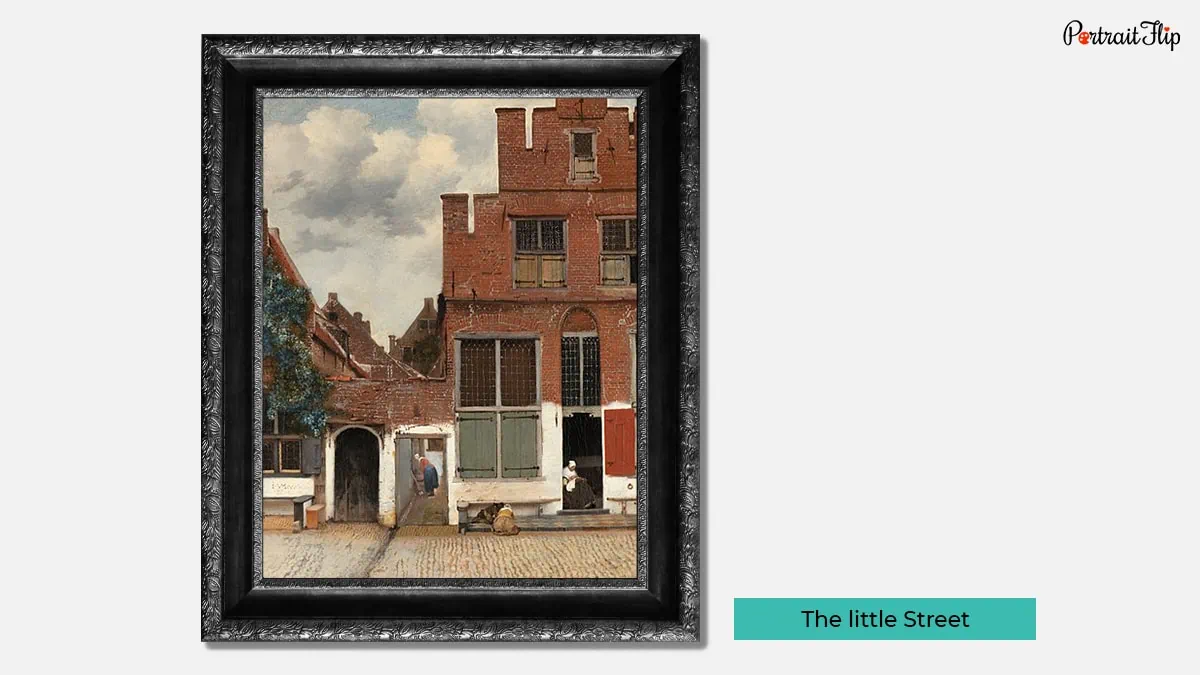
One of the most surreal Johannes Vermeer’s paintings, “The Little Street” is an expression of a quiet and mellow street in Delft, Netherlands, in the Dutch Golden Age.
This 1657 painting presumably depicts a glimpse from Vlamingstraat, Delft.
The use of pigments in this painting looks very minimal and balanced. Even though the color tone of this painting looks perfectly fine and subtle.
Dutch painter Vermeer has used this painting as a subtle walk down to his lane of memories. He created a house colored pencil portrait as a keepsake.
Vlamingstraat was one of his early residences in Delft. He has portrayed the simplicity and tranquility of the place with his prowess in handling colors.
The street itself gives a calming impression to the eyes at a glance. Vermeer’s message is clear: “No matter where you go, you’ll always find peace at home.”.
It is speculated that Vermeer used merely 4–5 pigments for this painting. which is a great feat altogether for one of the finest Johannes Vermeer artworks.
Writer’s Tip: You can create a house oil portrait by replicating this paining.
13. View Of Delft
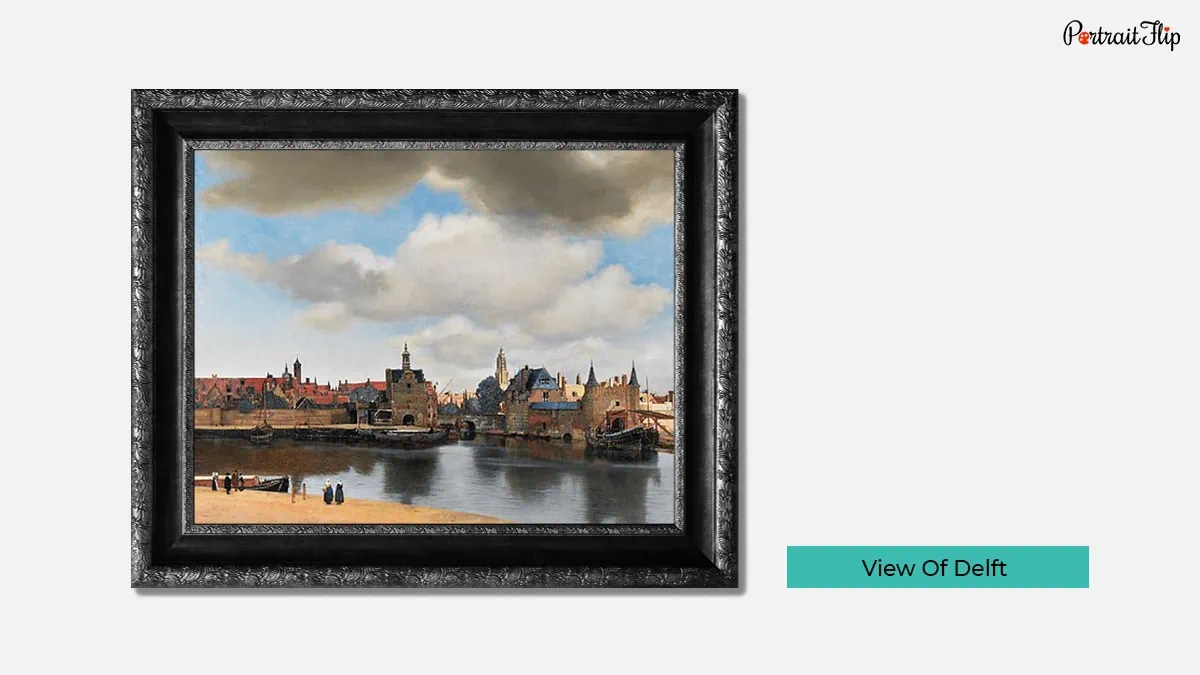
Considered the most popular cityscape painting of the Dutch Golden Age, “View of Delft” is a feather in Johannes Vermeer’s cap.
Another prominent example of Vermeer’s mastery with the use of natural light can be seen in this painting. Whether it’s the finely crafted cloudy sky, or highly nuanced Rotterdam gate, Vermeer has put in his expertise in every layer he painted.
One of the most clear and accurate sights of an old Dutch town is depicted in this painting. The fine detailing in drafting secondary elements speaks about the layers of life from every perspective.
Be it the buildings, the people or the boats, all of them portray different values and emotions in this artwork.
There’s silence yet there are conversations going on between people, there’s the limitless sky and the deep water, both of which depict the Vermeer’s thoughts.
Fun fact: Before painting this masterpiece, Vermeer created landscape pencil portrait of the View of Delft.
14. Women With A Pearl Necklace
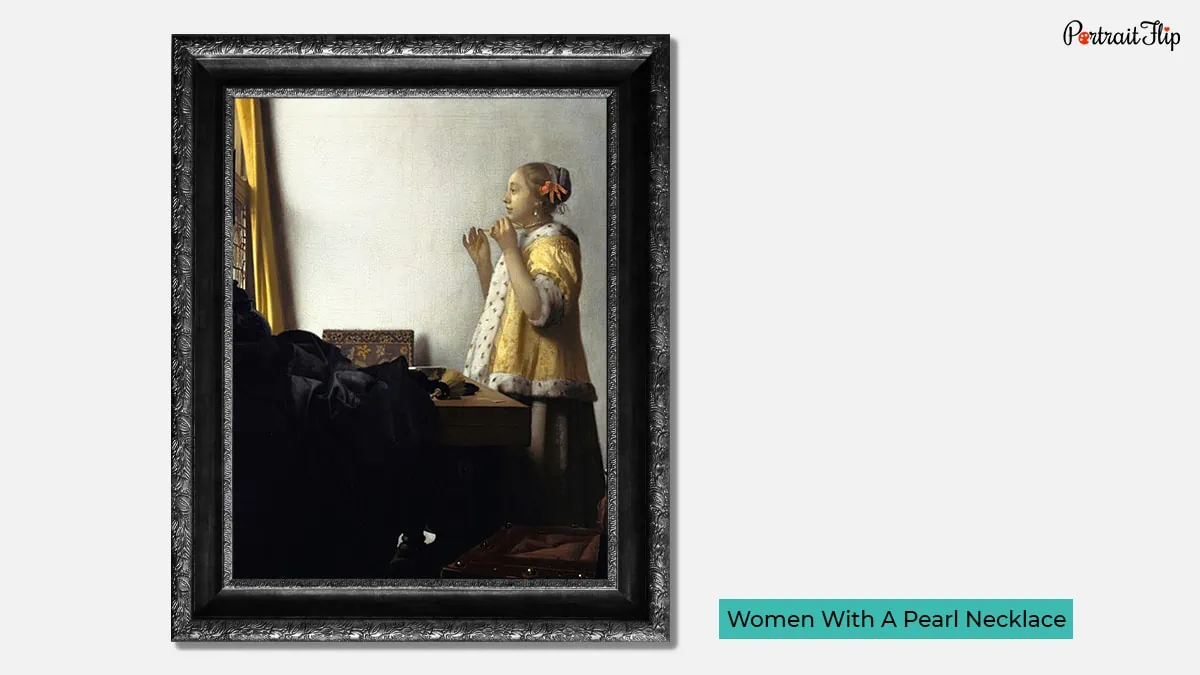
Painted by Dutch painter Vermeer in 1664, this painting follows similar color dynamics as Vermeer’s other women centric artworks.
The woman is wearing and holding a necklace and facing a casement window with a shower of sunlight on her body. Elegance happens to be an embedded element in this painting.
The woman hails from an upper class household, as pearls depict prosperity in the Dutch Golden Age. She looks quite happy yet calm while admiring her ornament.
This artwork celebrates the small moments of happiness that a woman experiences in her daily routine.
Johannes Vermeer’s paintings contain a lot of romanticism for middle class women of the Dutch Golden Age.
The use of vibrant colors, bright color schemes, and expensive pigments complement their presence in the frame.
15. Mistress And Maid
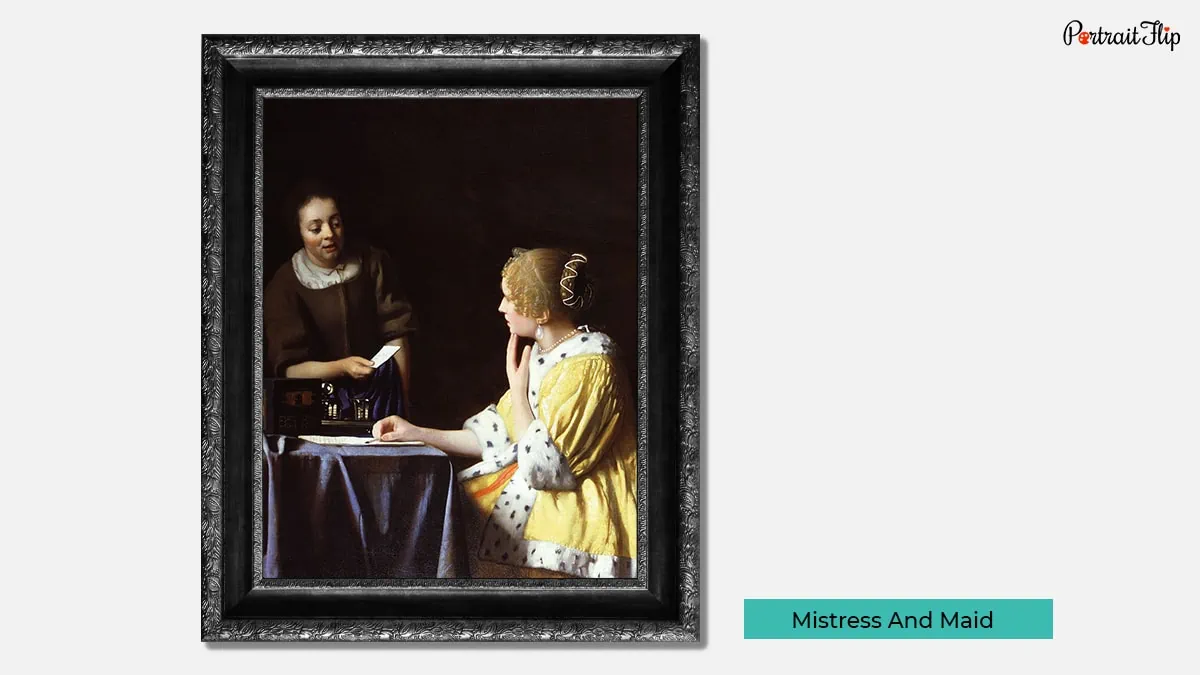
Mistress and Maid is a portrayal of two women of opposite stature in a single frame discussing a love letter.
The lustrous yellow color on the mistress’s dress leaves a remark of elegance and charm she has. On the other hand, the color scheme used for the maid is on the simpler side.
The maid’s facial expressions depict her inquisitive gape while she hands over the letter to the mistress. The mistress gives a demure gaze to the maid, her left hand is under her chin and she seems to be in a dilemma.
The mistress might be a bit angry at her maid for gazing at the letter before her. However, the maid looks in an apologetic manner and depicts her guilt for that act.
This conversational domiciliary scene unfolds a very peculiar yet true realization to us. Stature cannot define the emotional sensitivity of a person.
Epilogue:
Many art lovers wonder “How many Vermeer paintings are there?”. 36 out of 60 Johannes Vermeer’s paintings have survived 3 centuries and give evidence of his illustrious career as a painter.
However, 36 is fewer according to the average amount of the 17th century. This explains the fact that Vermeer’s artworks came to the mainstream a bit late (in the 19th century).
Vermeer knew how to read nuances in a painting as he had a family background in the art business.
One of the less-popular Johannes Vermeer facts is that his father used to deal in the sale of paintings from 1631 to the 1640s in Delft.
Vermeer not only created new accolades in the Dutch Golden Age paintings but also drafted some highly inspired artworks such as Saint Praxedis.
Author’s Note:
I thank you all for reading this piece about Johannes Vermeer’s paintings.
I hope you find this piece informative and fascinating. I’ve tried my best to enlist all the astounding paintings by Johannes Vermeer in this blog.
Still, if you guys have any suggestions, we’ll be more than happy to invite you all to the comment section.
We keep on posting this kind of content regularly. So keep in touch with us on Instagram and YouTube.
Explore our Johannes Vermeer Reproduction Paintings crafted to match the perfection of renowned artworks.
Dag lieve vrienden!
FAQs
Rembrandt Van Rjin, Johannes Vermeer, Jan Van Eyck and Vincent Van Gogh are some of the most prominent Dutch painters.
Artists like Jan Van Eyck, Johannes Vermeer and Rembrandt Van Rjin contributed in the Dutch Golden Age massively.
Girl with a pearl earring is the most talked about painting by Johannes Vermeer. It was even took as an adaptation and made into a movie.
Vermeer produced about 36 paintings in his lifetime. Out of which 34 were found in decent condition .






